by Brielle Colledge, Hourly Fisheries Technician
Bureau of Marine Fisheries
August 26, 2016
Have you ever been swimming in the ocean and seen what you thought was a shark fin? Or how about you fisherman, thinking you're reeling in a massive fish and it ends up being a skate (Rajidae) or stingray (Dasyatidae)? I know this has happened to me on more than one occasion. You're all excited thinking you've got a big one and it's going to be a record breaker. Then you finally see it and it's a big disappointment; it's just an annoying skate or stingray.
These two species are more common off our coast than you think. While many fishermen find these species to be a nuisance, they actually play a beneficial role in our waters. Their ideal food group consists of mollusks, crabs, small fish, and worms. Stingrays and skates use vibrations in the sand and water to help seek these prey. Once they have found a meal, these two families of fish flap their wings (pectoral fins), digging and displacing sand and organisms into the water column. These organisms can be a good food source for other species that take advantage of the skate and ray's messy eating habits. Both fish are also a beneficial food source for larger predators such as sharks and seals.
Stingrays and skates prefer temperate and tropical water temperatures. Including bays and locations close to shorelines, New Jersey's marine waters make an ideal place for them to inhabit. Some common species of skates that you will find off of our coast are: clearnose skates, little skates, rosette skates, barndoor skates, and winter skates. Common stingrays off of our coast are roughtail stingrays, bluntnose stingrays, bullnose rays, cownose rays, and spiny butterfly rays.
An interesting fact about these fish is that stingrays have live births while skates lay eggs. You have probably seen the black egg sacks wash up on the beaches. They are commonly known as mermaid purses. Skates, stingrays and sharks are closely related. They are all cartilaginous fish, meaning they have no bones. Like sharks, they have five or more gill slits on each side. Bony fish like summer flounder, striped bass, and bluefish have only one gill slit.
Clearnose Skate (Raja eglanteria)
Range from Massachusetts - Florida, and are considered an in-shore skate. They spend their time off our coast from late spring to early fall, preferring water temperatures from 50°F - 70°F. Clearnose Skates are brown on top with dark brown spots. They have a translucent space located on either side of the snout; it is also elongated and pointed. The tail is thick with wide, brown crossbars. A single row of thorns are located along the midline.
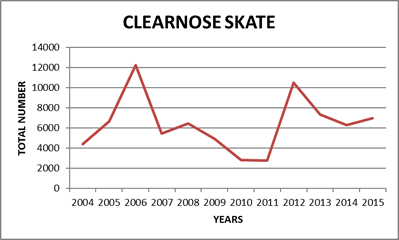
According to NJ F&W's Ocean Trawl Survey data, a total of 76,796 Clearnose Skates were caught from 2004 - 2015
|
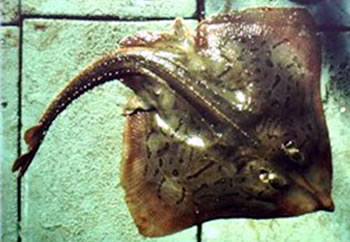
Courtesy James Maloney
|
Little Skate (Raja erinacea)
Range from southern Gulf of St. Lawrence and Nova Scotia to North Carolina. Little Skates prefer sandy or gravelly bottoms. Their size ranges from 16 to 20 inches. They are the most plentiful in northern inshore waters in the summer.

According to NJ F&W's Ocean Trawl Survey data, a total of 132,108 Little Skates were caught from 2004 - 2015.
|

Courtesy James Maloney
|
Rosette Skate (Raja garmani)
Range from southern New England to south Florida. They mostly inhabit the outer edge of the continental shelf and the upper part of the continental slope. They prefer water depths of 180 feet - 1740 feet. Alternate names are Leopard Skate or Freckled Skate. With the maximum size of 16 inches, they have light to brown markings and whitish spots. From the tip of the tail to the mid- section of the body; there are three to five rows of large thorns. The Ocean Trawl Survey has never caught a Rosette Skate.
|

Courtesy George Burgess
|
Barndoor Skate (Raja laevis)
Range from Grand Banks, Newfoundland to North Carolina. They prefer deeper waters during the warmer months, about 1410 feet. They are an active skate, ready to take your bait. Their coloration is light brown with small dark brown spots. The snout has a very distinct point and the front of the pectoral fin is concave (cut inward). Barndoors have grayish bottom colorations and their tail has three rows of spines. The Ocean Trawl Survey has never caught a barndoor skate.
|
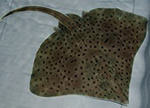
Courtesy Florida Museum of Natural History
|
Winter Skate (Raja ocellata)
Range from Newfoundland Banks and southern Gulf of St. Lawrence to North Carolina. In the northern parts they prefer gravelly, sandy bottoms in shallow waters. Winter Skates are similar to Little Skates, however Winter Skates have more rows of teeth in their upper jaw.
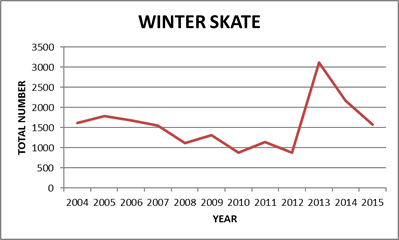
According to NJ F&W's Ocean Trawl Survey data, a total of 18,849 Winter Skates were caught from 2004 - 2015.
|

NJDFW
|
Roughtail Stingray (Dasyatis centroura)
One of the largest of all the stingrays, 7 feet across and 14 feet long. They range from Georges Banks and Cape Cod to Cape Hatteras and rarely to southern Florida. There is a black fold of skin along the base of the tail, along with rows of small thorns. Three barbs (spines) are located on the tail. Barbs are poisonous but are rarely life threatening to humans.
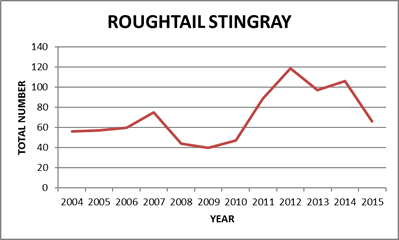
According to NJ F&W's Ocean Trawl Survey data, a total of 856 Roughtail Stingrays were caught from 2004 - 2015
|

Courtesy NOAA National Marine Fisheries Service, Northeast Fisheries Science Center
|
Bluntnose Stingray (Dasyatis sayi)
Range from New Jersey to southern Brazil. They have a diamond shaped pectoral disc. Range in colors such as yellowish, light brown, grayish, olive, reddish brown or dusky green. Like the name bluntnose suggests, the snout is blunt and short. On the upper and lower surface of the tail is a well-developed fold. Preferring to bury themselves in the sand, sometimes they are stepped on by bathers causing serious and painful injuries.

According to NJ F&W's Ocean Trawl Survey data, a total of 77 Bluntnose Stingrays were caught from 2004 - 2015.
|
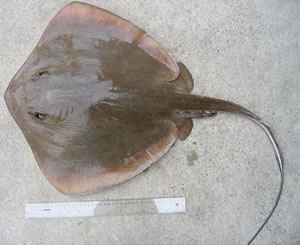
Courtesy Texas Parks and Wildlife Department
|
Bullnose Stingray (Myliobatis freminvillei)
Prefer coastal waters from Cape Cod to southeastern Florida. This stingray swims in mid-water, sometimes even leaping to skim the water's surface. Pectoral fins are large with pointed tips. Their snout is thin and elongated like a duck bill. The tail is long and slender with a long spine near the base. Colors can range from grayish, reddish brown or dark brown

According to NJ F&W's Ocean Trawl Survey data, a total of 6,589 Bullnose Stingrays were caught from 2004 - 2015.
|

Courtesy NOAA National Marine Fisheries Service, Northeast Fisheries Science Center
|
Cownose Stingray (Rhinoptera bonasus)
Range from southern New England to northern Florida and the entire Gulf of Mexico. Cownose Stingrays migrate to Trinidad, Venezuela and Brazil in large schools, but for some unknown reason disappear off the coast of northern Florida. They prefer coastal waters but do enter estuaries. These stingrays occasionally jump out of the water, creating a loud smack. Coloration of brown to olive, with no spots or markings. Pectoral fins are long and pointed. Their snout is projecting and square, looking similar to a cow's nose. The tail is long and whip-like with a barb located near the base.

According to NJ F&W's Ocean Trawl Survey data, a total of 745 Cownose Stingrays were caught from 2004 - 2015.
|

Courtesy the Chesapeake Bay Program
|
Spiny Butterfly Ray (Gymnura altavela)
Ranging from Massachusetts to Argentina, they prefer sandy bottoms, estuaries, or rocky reef faces from 2 - 100 meters (7 - 238 feet) deep. The wing span of a spiny butterfly ray can get up to 13 feet. Intricate patterns of tiny lines and swirls range from light to dark. Their tail is very short compared to other sting rays, with one to two barbs.

According to NJ F&W's Ocean Trawl Survey data, a total of 171 Spiny Butterfly Ray were caught from 2004 - 2015.
|

copyright Andy Murch, all rights reserved
|
Skates and stingrays have been around for the past 150 million years, based on fossil records. So what you see as an annoying animal that might ruin your day fishing is actually an ancient creature that has been on this planet longer than mankind. The first humans evolved only 4 million years ago. Some species are just misunderstood and if just looked at from a different perspective can be viewed with far greater appreciation.
In the words of Charles Darwin, "It is not the strongest of the species that survive, nor the most intelligent, but the one most responsive to change."
References:
Parson, Glenn R. Sharks, Skates, and Rays of The Gulf of Mexico: A field guide Mississippi: Mississippi Department of Marine Resources, 2006. Print.
Elasmodiver site map. (n.d.). Retrieved May 14, 2016, from www.elasmodiver.com/site map.htm
Robins, Richard C. Ray, Garleton G. Douglass, John. Atlantic Coast Fishes Peterson Field Guides: Boston, 1986. Print.


















